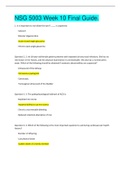Summary
Summary data mining and its applications (including book and lectures)
- Course
- Institution
- Book
Summary of the subject data mining and its applications at Rijksuniversiteit Groningen. Year 2 of bedrijfskunde / pre-master. Summary of the relevant chapters of the book and the lecture slides. You can also bring this to the exam.
[Show more]








